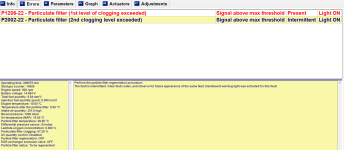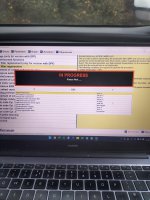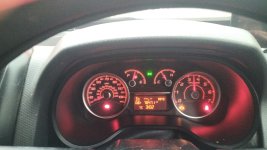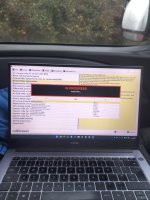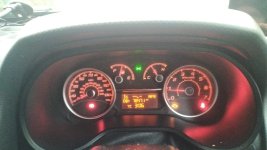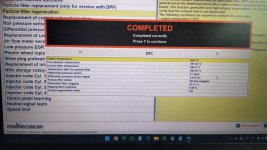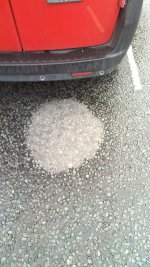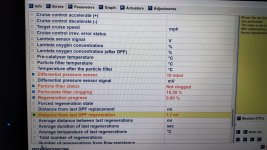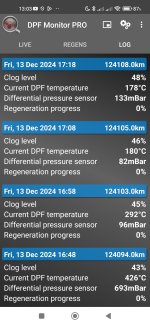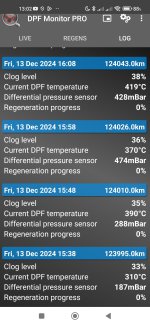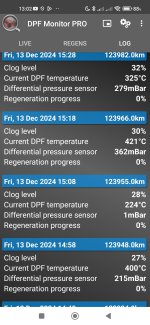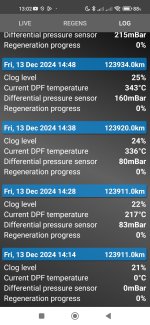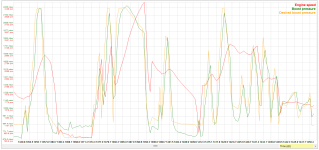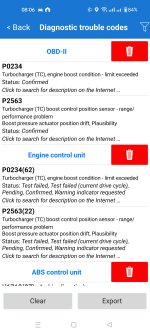Hi folks
I managed to blag a 1.3 Multijet2 Doblo 2018 for silly money as it was advertised as having DPF issues. First thing I did was change the oil and filter, and reset the oil counter using the pedal trick.
I can confirm it does indeed have DPF issues. Whilst the standard OBD readers only find P2002 (22), a VLink iCar Pro BL 4.0 plus CarScanner app on Android pointed the finger at P1206-22. Clearing the code does nothing - it's straight back on again as soon as the revs rise significantly.
Watching the differential pressure sensor readings in the wonderfully useful DPF Monitor app https://play.google.com/store/apps/details?id=com.kapron.ap.dpfmonitor&hl=en
I was able to ascertain that the pressure readings go off the chart. Here's some examples:

I took it for a long old drive on Saturday (with P1206 still present, so progress was slow), belted up and down the M1 a junction (J26->J25->J26) and parked up at a quiet industrial estate with the idea of clearing the P1206 quickly and forcing a regen with the pedal press trick. No dice. Mind you by this time the blockage was showing as 107%.
Weirdly, as I drove home very gently from the industrial estate (less than a third of a mile in a 20mph restriction) the van began regen, so I took it for a good old run down the M1 again (J26->J23A->J26) by which time the regen had fully completed (to 13% clogging), and the differential pressure was down again. Happy days, thought I....
Sadly my victory was short lived. As I am a national same day courier, I drive many miles. I drove to that London on the Sunday and after about 120 miles up came the P1206 code and P2002 code again. Clogging levels weren't massive, say 50%.
I drove all the way from Scratchwood Services (between J2 and J4) to Trowell Services (between J25 and J26) as the limp mode was manageable (poor weather conditions, everyone driving slow). Tried to reset the codes again, came up as soon as I left the services, no regen this time even though the temperature started rising (and subsequently went down again). Massive differential pressure readings again - reached as high as over 600Mbar. The one thing I did note that (when the engine was cool the following day) the oil level was right down on the dipstick - took a litre to refill. I'm hoping this isn't being sucked into the turbo, but one problem at a time.....
I have secured Multiecuscan and the various cables, but as this is a 2018 model I also need the SGW bypass cable, which I'm waiting on. I did take some readings on the DPF with read only access - never replaced, done over 600 regens in 78000 miles, last regn accurately recording, differential pressure reading 0 Mbar at ignition on/engine off, and around 50-70 idle. Clearly these readings are way too high. Differential pressure sensor voltages read fine (between 0.5 at idle and 4.5V at 2500rpm). Oil degradation level showing 94% which seems right, apparently the van has done three regens since I did that (it part did one on the way to Salisbury on the Thursday then threw up the codes, I suspect it part did one to London too, plus the full one I witnessed on DPF monitor).
Anyroad, plan of action:
- get engine to temp, maybe a 20 min 1 junction loop on the M1, clear codes with Multiecuscan once the SGW cable is in place, force regen, take it for a good old hoon once cooled.
Everything points to a full to bursting DPF.
I'm also wondering whether it's worth (once the first force regen is done) resetting the DPF and differential pressure sensor settings (ie 'replacing' them), doing a second foced regen and then another hoon to recalibrate. However, I'm wary that this may create more problems than it solves, so will hold off for now.
Thoughts ? Worth getting a DPF clean ?
And no, DPF delete and remap really would have to be the last resort. Given the DVSA's propensity for roadside checks, I can't risk a £2500 fine which is what commercial van drivers face if there has been DPF skullduggery. It really needs to be legit if poss (though the extra 20 horses would be nice, as would the improved MPG)
I managed to blag a 1.3 Multijet2 Doblo 2018 for silly money as it was advertised as having DPF issues. First thing I did was change the oil and filter, and reset the oil counter using the pedal trick.
I can confirm it does indeed have DPF issues. Whilst the standard OBD readers only find P2002 (22), a VLink iCar Pro BL 4.0 plus CarScanner app on Android pointed the finger at P1206-22. Clearing the code does nothing - it's straight back on again as soon as the revs rise significantly.
Watching the differential pressure sensor readings in the wonderfully useful DPF Monitor app https://play.google.com/store/apps/details?id=com.kapron.ap.dpfmonitor&hl=en
I was able to ascertain that the pressure readings go off the chart. Here's some examples:
I took it for a long old drive on Saturday (with P1206 still present, so progress was slow), belted up and down the M1 a junction (J26->J25->J26) and parked up at a quiet industrial estate with the idea of clearing the P1206 quickly and forcing a regen with the pedal press trick. No dice. Mind you by this time the blockage was showing as 107%.
Weirdly, as I drove home very gently from the industrial estate (less than a third of a mile in a 20mph restriction) the van began regen, so I took it for a good old run down the M1 again (J26->J23A->J26) by which time the regen had fully completed (to 13% clogging), and the differential pressure was down again. Happy days, thought I....
Sadly my victory was short lived. As I am a national same day courier, I drive many miles. I drove to that London on the Sunday and after about 120 miles up came the P1206 code and P2002 code again. Clogging levels weren't massive, say 50%.
I drove all the way from Scratchwood Services (between J2 and J4) to Trowell Services (between J25 and J26) as the limp mode was manageable (poor weather conditions, everyone driving slow). Tried to reset the codes again, came up as soon as I left the services, no regen this time even though the temperature started rising (and subsequently went down again). Massive differential pressure readings again - reached as high as over 600Mbar. The one thing I did note that (when the engine was cool the following day) the oil level was right down on the dipstick - took a litre to refill. I'm hoping this isn't being sucked into the turbo, but one problem at a time.....
I have secured Multiecuscan and the various cables, but as this is a 2018 model I also need the SGW bypass cable, which I'm waiting on. I did take some readings on the DPF with read only access - never replaced, done over 600 regens in 78000 miles, last regn accurately recording, differential pressure reading 0 Mbar at ignition on/engine off, and around 50-70 idle. Clearly these readings are way too high. Differential pressure sensor voltages read fine (between 0.5 at idle and 4.5V at 2500rpm). Oil degradation level showing 94% which seems right, apparently the van has done three regens since I did that (it part did one on the way to Salisbury on the Thursday then threw up the codes, I suspect it part did one to London too, plus the full one I witnessed on DPF monitor).
Anyroad, plan of action:
- get engine to temp, maybe a 20 min 1 junction loop on the M1, clear codes with Multiecuscan once the SGW cable is in place, force regen, take it for a good old hoon once cooled.
Everything points to a full to bursting DPF.
I'm also wondering whether it's worth (once the first force regen is done) resetting the DPF and differential pressure sensor settings (ie 'replacing' them), doing a second foced regen and then another hoon to recalibrate. However, I'm wary that this may create more problems than it solves, so will hold off for now.
Thoughts ? Worth getting a DPF clean ?
And no, DPF delete and remap really would have to be the last resort. Given the DVSA's propensity for roadside checks, I can't risk a £2500 fine which is what commercial van drivers face if there has been DPF skullduggery. It really needs to be legit if poss (though the extra 20 horses would be nice, as would the improved MPG)


